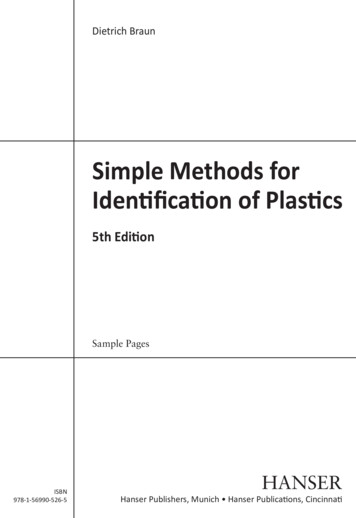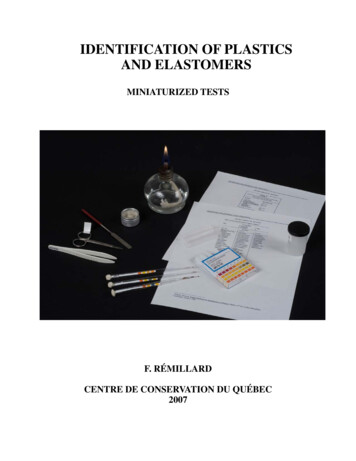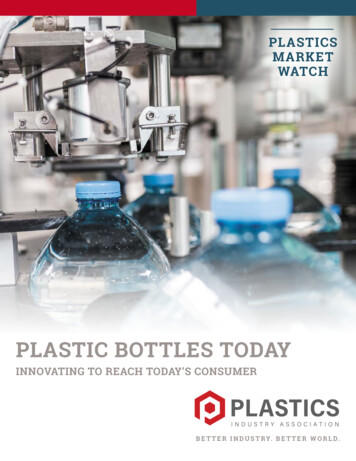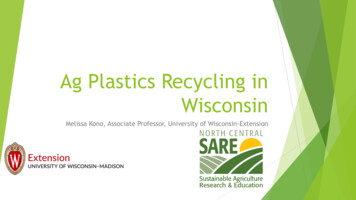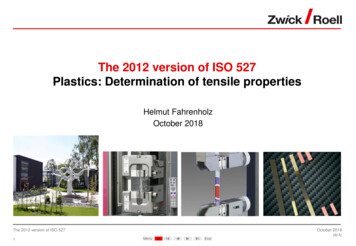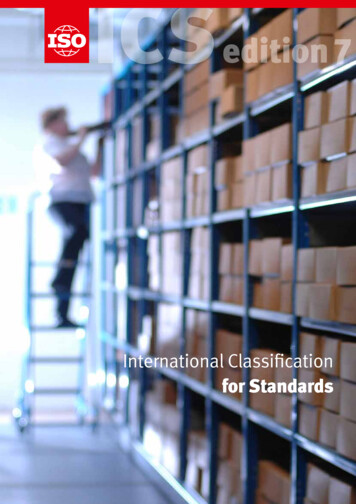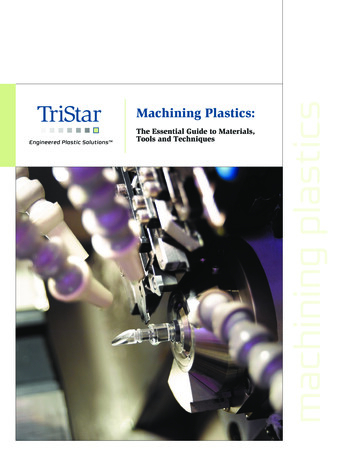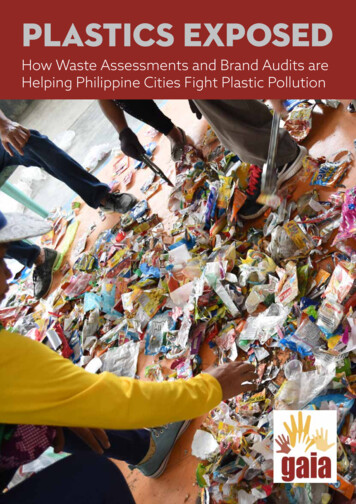
Transcription
Plastics exposedHow Waste Assessments and Brand Audits areHelping Philippine Cities Fight Plastic Pollution
2 PLASTICS EXPOSED
Plastics exposedHow Waste Assessments and Brand Audits areHelping Philippine Cities Fight Plastic Pollution 2019 Global Alliance for Incinerator AlternativesUnit 330, Eagle Court Condominium26 Matalino Street, Barangay CentralQuezon City, Philippines 1100www.no-burn.orgGAIA is a global network of more than 800 grassroots groups, NGOs,and individuals. We envision a just, Zero Waste world built on respectfor ecological limits and community rights, where people are free fromthe burden of toxic pollution, and resources are sustainably conserved,not burned or dumped. We work to catalyze a global shift towardsecological and environmental justice by strengthening grassroots socialmovements that advance solutions to waste and pollution.ACKNOWLEDGEMENTSGAIA is grateful for the work of Mother Earth Foundation in developingthe methodology used in the Waste Assessment and Brand Audit(WABA). Utmost appreciation is likewise extended to the localgovernments of Quezon City, Malabon, Navotas, City of San Fernando(Pampanga), Batangas City, Tacloban City, and the province of NuevaVizcaya for adopting the waste assessment findings in their respectivewaste management plans, as well as taking steps toward achievingZero Waste. Finally, the team behind this publication is thankful to theUniversity of Santo Tomas’ Research Center for Social Sciences andEducation (RCSSEd), particularly to Dr. Belinda De Castro and Mr. ZosimoMembrebe, Jr. for overseeing the extrapolation process, and to thePlastic Solutions Fund for its support to the Zero Waste Cities work inthe Asia-Pacific region, under which these WABAs were conducted.PLASTICS EXPOSED3
TABLE OF CONTENTSLIST OF TABLES 5EXECUTIVE SUMMARY 6ACRONYMS AND ABBREVIATIONS 9CURRENCY EQUIVALENTS 9INTRODUCTION 10Context 13Overview 15METHODOLOGY16Brand audit data 20Assumptions and limitations 20RESULTS 21Waste assessment results 21Brand audit results 26CASE STUDIES 30HOW WABA DATA WAS USED IN SELECTEDZERO WASTE CITIES PROJECT SITESA.Maximizing waste diversion rates30through regulation of selected residual materialsB.Engaging informal waste workers as32door-to-door waste collectors, generating jobsand servicing areas previouslynot covered by truck collectionC.WABA and designing community composting facilities35D.Designing Eco-shed MRFs from WABA data36E.How WABA data reveals trends on volumes38of substitute materials in areas thathave instituted plastic bag regulationsF.Using WABA to project landfill capacity and lifespan,39and support investment in Zero Waste strategiesG.WABA data to be used in40waste management plans in IndonesiaCONCLUSIONS AND RECOMMENDATIONS 41ANNEXZero Waste Cities Project 50Waste and Brand Audit Data Sheets4 PLASTICS EXPOSED52
LIST OF TABLESTable 1.Cities and municipalities whose waste assessment and 16brand audit data were used for this reportTable 2.Summary of MEF’s WABA methodology 17Table 3.MEF and GAIA waste assessment sites, categorization 18based on economic profile and geographic location,and population percentage of each categoryTable 4.Per capita waste generation 22Table 5.Number of pieces and percentage share of the23types of plastic residuals from the 21 study sitesTable 6.Plastic sando shopping bags and plastic labo bags24discarded per capita per week in the selected project sitesTable 7.Estimated number of sachets, plastic sando shopping bags,25plastic labo bags, and disposable diapersused per person per year, and for the entire Philippines per dayTable 8.Projected income from recyclables, per study site 26Table 9.Number of pieces of plastic residual waste,according to whether the plastic waste was branded or not 28Table 10.Companies with the most number of branded 29residual waste identified in the household WABAs,number of pieces, and percentage as a fraction of allresidual waste, and all branded waste collectedLIST OF FIGURESFigure 1Waste Characterization ofHousehold Waste in the Philippines 22Figure 2Branded vs Unbranded Plastic Residuals 27Figure 3Waste diversion rate (2012–201831in the City of San Fernando, PampangaPLASTICS EXPOSED5
EXECUTIVESUMMARYSingle-use disposable plasticis the greatest obstacle tosound waste and resourcemanagement. Inadequatewaste management systems andhuman negligence are often citedas the main contributors to plasticwaste leakage into terrestrial andmarine environments—but waste andbrand audit data in many parts ofthe world are helping reveal that theunfettered production of disposableplastic is the actual problem. As longas the mass production of throwawayplastics continues unabated, cities andcountries will find it harder and harderto cope. Put simply, disposable plasticis a pollution problem, and the onlyway to prevent it is to stop it at source.This report gives a snapshot of the plasticpollution problem with a focus on thePhilippines, where a number of cities aretrying to implement sustainable Zero Wastestrategies. Their complete success, however,is being hindered by the proliferation of plasticbags, sachets, and other disposable plasticpackaging and products. Using data gatheredfrom the Global Alliance for IncineratorAlternatives’ (GAIA’s) Zero Waste Cities projectsites, this research provides new quantitativeevidence to support the global call for theplastics industry and manufacturing companiesto immediately reduce and eventually stopproducing single-use plastics as the primarysolution to end plastic pollution.The data in this report was gathered throughthe waste assessment and brand audit (WABA)tool developed by the NGO Mother EarthFoundation (MEF), a group implementing GAIA’sZero Waste Cities project in the Philippines.Currently, there is a lack of extensive datain the country regarding the production,consumption, and disposal of single-use6 PLASTICS EXPOSEDplastics and plastic packaging. For example,there is no data on the total sachet productionof companies, which make up a significantportion of throwaway plastics in dumps,waterways, and beaches. Traditional wasteassessment and characterization surveys(WACS) also do not distinguish betweenthe different types of plastic packaging,preventing effective policy making for theirproper management. This report thereforealso highlights the importance of WABAs asa vital tool to give detailed information aboutthe types, volume, and number of plasticwaste in cities and municipalities, and tosupport strategies to deal effectively with thisproblematic waste stream.As a tool, WABAs help 1) expose the role ofspecific corporations in the global proliferationof plastic waste; 2) unmask how the industryhas passed on the blame for the waste theyproduce to the consumers of their products,and the responsibility for clean-up of theirpackaging to governments1; and 3) reinforce theneed for corporations to accept liability for thefull life-cycle impacts of their products and thepackaging in which their products are sold.This report compiles data from 21 wasteassessments conducted in six cities and sevenmunicipalities across the Philippines by MEF
MEF volunteers sort branded plastic residuals during a waste audit in Quezon City GAIA/SHERMA BENOSAand local government project partners, with thesupport of GAIA and funding from the PlasticSolutions Fund. Results from the 21 wasteassessments were used to extrapolate nationaldata, including estimates about the use anddisposal of different types of plastic residuals.Among the 21 sites where waste assessmentswere conducted, 15 sites have additional brandaudit data. These data provide a snapshotof how much plastic waste, particularlythose with branded packaging, are discardedby households.Based on WABAs conducted in areas acrossthe Philippines, findings highlighted in thisreport confirm that:1.Organic waste comprise more than 50%of generated waste in the Philippines,affirming that organic waste managementis an important strategy that willcreate substantial waste reduction forlocal governments.2. Disaggregating data on the different typesof plastic residuals gives a clearer pictureof waste generation, providing valuableinformation on policy actions needed tosubstantially reduce this highly problematicwaste stream.3. The strict implementation of plastic bagregulations produces dramatically significantresults in lowering plastic bag use. However,the existence of a plastic bag regulation in acity or municipality does not automaticallyequate to lower plastic bag use.4. Almost 164 million pieces of sachets areused in the Philippines daily, equatingto around 59.7 billion pieces of sachetsyearly. With the absence of policiesmandating liability and accountabilityfor the production of this problematicwaste stream, cities and municipalitiesare left to deal with this problem usingtaxpayers’ money.5. While more attention should be given toensure the reusability of packaging andproducts, it is important to acknowledgethat within current waste managementsystems, recycling plays an important rolein supporting livelihoods, and creatingadditional income for households, villagesand/or municipalities and cities.6. More than 50% of all unrecyclableresidual waste discarded in the countryis branded waste, and only 10 companiesare responsible for 60% of all brandedwaste in the study sites. This highlights theurgent need for interventions that involvemanufacturers in taking responsibility fortheir plastic waste, primarily by drasticallyreducing production of throwawayplastic packaging.PLASTICS EXPOSED7
MEF staff and Zero Waste Academy participants weigh recyclables during a waste assessment and brand audit in Dumaguete City. GAIA/SHERMA BENOSAUsing WABA data, this research extrapolatesnational estimates on annual per capita use ofplastic shopping bags, plastic labo, and sachetsin the Philippines. Findings show that:1. The average Filipino uses 591 pieces ofsachets, 174 shopping bags, and 163 plasticlabo bags, yearly.48 million shopping bags2. Everyday, almost 57are used throughout the Philippines, or17.5 billion pieces a year.roughly 20.63. Plastic labo bag use throughout thePhilippines is at 45.2 million pieces per day,or 16.5 billion pieces a year.4. Around three million diapers are discardedin the Philippines daily, or 1.1 billiondiapers annually.These figures show that the sheer volume ofresidual waste generated daily is beyond thecapacity of barangays, cities and municipalitiesto manage: the problem is the huge amountof single-use plastics being produced, not theway the waste is managed. Experiences inGAIA’s Zero Waste Cities project sites showthat after implementing Zero Waste strategies(for example establishing working materialsrecovery facilities or MRFs, conducting doorto door segregated collection, compostingorganics, and maximizing recycling of highvalue materials, etc.) cities can only achieve8 PLASTICS EXPOSEDa maximum of 70-80% waste diversion (i.e.maximizing the sustainable management ofdiscards to avoid landfilling and other finaldisposal methods) compared to their pre-ZeroWaste program baseline. Despite expandingZero Waste strategies, cities and municipalitieswill be left with around 20% of waste that theycannot manage—sachets and other single useplastics—preventing them from fully achievingZero Waste goals.Clearly, plastics are a global problem withlocal repercussions, and it is the cities andmunicipalities, as well as ordinary citizens,who bear the brunt of the problem. But theplastic crisis can be tackled, starting with usingWABA as a tool.Several case studies of Zero Waste Citiesproject sites in the Philippines featured in thisreport show how WABA data was used in wasteand resource management planning to:1. Maximize waste diversion rates;2. Create a system to efficiently collectsegregated waste from previously hard-toreach areas while creating jobs for informalwaste workers;3. Design eco-sheds for materialsrecovery facility;4. Design community composting facilities;
5. Predict landfill capacity and lifespan,and support investment in Zero Wastestrategies; and6. Reveal trends in plastic use in a cityand municipality for monitoring andimprovement of regulations.While this report is focused on examples fromthe Philippines, the experiences related hereare not unique, and the recommendations inthis report are applicable in other countries.Cities all over Asia and in the developing worldin general are faced with the same problemof plastic residuals, most of which have beenidentified as branded plastic packaging frommultinational corporations (MNCs) basedin the global north. This points to the needfor a global plastic regulation to reduce andeventually eliminate the production of singleuse plastic products and packaging.Based on the findings, this report gives thefollowing recommendations:1. WACS protocols should includedisaggregated data on different types ofplastic bags and packaging.2. Cities and municipalities should includebrand data in waste assessments.3. The Philippine government should institutea comprehensive national plastic bag banthat promotes reusable bags.4. Governments should regulate othersingle-use plastic products, and mandatecompanies to redesign products andpackaging and put in place alternativedelivery systems.5. Governments should mandate diapercompanies to improve recovery optionsfor, and present viable alternatives to,disposable diapers.6. Waste incineration is an unsustainablepractice that abets plastic pollution andmust be stopped. In the Philippines, thegovernment must retain and strengthenthe ban against waste incineration.7. Corporations must be transparent aboutthe plastic packaging they produce,assume accountability and liability forthe packaging, and immediately stopproducing throwaway plastic packagingthrough innovations in redesign andproduct delivery.ACRONYMS AND ABBREVIATIONSEPRExtended Producer ResponsibilityDENRDepartment of Environment and Natural ResourcesDOFDepartment of FinanceFMCGFast-moving Consumer GoodsLGULocal Government UnitMEFMother Earth FoundationMMDAMetropolitan Manila Development AuthorityMRFMaterials Recovery FacilityNSWMCNational Solid Waste Management CommissionPSAPhilippine Statistics AuthorityRA 9003Republic Act No. 9003 (Ecological Solid WasteManagement Act of 2000)SWMSolid Waste ManagementWACSWaste Analysis and Characterization StudyWABAWaste Assessment and Brand AuditCURRENCYEQUIVALENTS(As of 18 February 2019)2USD 1.00 PHP 52.2963PHP 1.00 USD 0.01912PLASTICS EXPOSED9
INTRODUCTIONPlastic waste littering Manila BayI GAIA/PAULA DE CASTROt is estimated that more than8,300 million metric tonsof virgin plastic have beenproduced globally. Cheap toproduce, plastics have been used for avariety of purposes, from car parts toproduct packaging. However, its endof-life management, particularly forplastics that are single use in nature,is currently in question: only around9% of discarded plastic have so farbeen recycled. The rest are eitherburned, landfilled, or released intothe environment (e.g. waterways,streets, etc.)3.10 PLASTICS EXPOSEDInadequate waste management systemsand human negligence are often cited as themain contributors to plastic waste leakageinto terrestrial and marine environments 4.This misinformation continues to bepromoted by the plastics industry, allowingit to deflect responsibility and liability forplastic waste 5. In the meantime, the sameindustry, together with manufacturers offast-moving consumer goods, continuesunimpeded in their plans to expand theproduction of disposable packagingand products.The unfettered production of materialscreated in order to be discarded is sendinga global wake-up call that single-use,disposable plastic—not the way it ismanaged—is the problem.
This report providesnew quantitativeevidence to supportthe global call forthe plastics industryand manufacturingcompanies toimmediately reduceand eventually stopproducing singleuse plastics, as theprimary solution to endplastic pollution.This report provides new quantitative evidenceto support the global call for the plasticsindustry and manufacturing companies toimmediately reduce and eventually stopproducing single-use plastics, as the primarysolution to end plastic pollution. Usingdata gathered from the Global Alliance forIncinerator Alternatives’ (GAIA’s) Zero WasteCities6 project sites in the Philippines, thisreport demonstrates how disposable plastic isthe greatest obstacle to achieving sustainableresource and waste management.plastic waste—which can make up as muchas 30% of waste generated—to landfills, orworse, open dumpsites. For example, the 17cities and municipalities in the Philippine’sbiggest metropolis, Metro Manila, spentPHP4.221 billion ( USD80.7 million) for wastemanagement in 2012.7 This amount does notinclude costs shouldered by the MetropolitanManila Development Authority (MMDA8) forwaste management and tipping fees.At present, little concrete data is available onthe extent of plastic packaging as well as otherproblematic plastics in the waste streams ofPhilippine cities. Using existing data from aninnovative tool, the Waste Assessment andBrand Audit (WABA), this report providesinformation about the amount of plastics beingdiscarded by Philippine households. The reportestimates how many sachets (e.g. instantcoffee, shampoo, etc), plastic shopping bags,and other plastic packaging are discarded in thecountry. Extrapolated figures show a per capitaestimate of plastic consumption for the wholePhilippines.Data and findings in this report are significantnot just to local and national audiences inthe Philippines. Other governments in theAsia-Pacific region and beyond who arestruggling with huge amounts of plastic wasteand branded packaging waste, may find useand application for the WABA methodology,findings, and recommendations proposed here.Since 2016, GAIA has been working with cities inthe Asia-Pacific region to strengthen resourceand waste management programs. However,household waste assessments conductedfor these projects show that because of themassive amount of throwaway plastics, citiesstill struggle with waste management—despitethe implementation of ecological waste andresource management systems.Zero Waste Cities project areas in thePhilippines, for example, manage to recoverand divert from landfills 70-80% of their solidwaste by composting organic waste and sellingrecyclable discards to waste markets. However,these cities still spend a considerable amountof taxpayers’ money to haul non-recyclableBranded plastic sachetscollected for a brand audit GAIA/SHERMA BENOSAPLASTICS EXPOSED11
Currently, many inter-governmental bodies atregional and international levels are lookingfor collaborative solutions to the global plasticcrisis. Information in this report may be usefulto give details about local realities of plasticwaste—particularly branded plastic wastepeddled by multinational companies—incountries in the global south. Case studiesand recommendations presented in thisreport show examples of local solutions andinitiatives that would give developing countryperspectives in international discussions.Nationally, the findings of this reportare relevant in informing the Philippinegovernment, local governments, corporateactors, other non-government organizations,and Filipino consumers about the severityof the plastic problem and their roles inaddressing it.Based on the findings of this report, GAIA isproposing recommendations for internationalbodies and governments of countries wheremultinational corporations are headquarteredto heed and address the realities in developingcountries; for the Philippine government toinstitute policies to reduce and regulate plasticproduction and use; and for manufacturingcorporations to first and foremost reduceplastic production and packaging, and redesigntheir products and delivery systems.This report additionally seeks to highlightthe importance of WABAs as a vital tool ininforming governments about the plasticpackaging waste problem in cities andmunicipalities. WABA data may serve asreference in pursuing policy actions such as12 PLASTICS EXPOSEDData and findings in this reportare significant not just to localand national audiences in thePhilippines. Other governments inthe Asia-Pacific region and beyondwho are struggling with hugeamounts of plastic waste andbranded packaging waste, mayfind use and application for theWABA methodology, findings, andrecommendations proposed here.bans or selective regulations, and measures tocompel corporate actors to acknowledge theirliability for the harm caused by plastic pollution(including historical plastic pollution) anddrastically reduce plastic production.Finally, in this report, GAIA shines thespotlight on cities that are pursuing ZeroWaste programs in order to show how localauthorities have effectively used WABAinformation to strengthen regulations,improve waste management services, andreduce waste volume and its correspondingmanagement costs.
ContextBackground about Waste Assessment and BrandAudits (WABAs)Currently, there is a lack of extensive datain the Philippines regarding the production,consumption, and disposal of plastics andplastic packaging. For example, data on thetotal sachet production8 of companies, whichmake up a significant portion of throwawayplastics in dumps, waterways, and beaches,are absent and continues to be undisclosedbecause they are considered confidentialindustry information. Traditional wasteassessment and characterization surveys(WACS) also do not distinguish between thedifferent types of plastic packaging disposed(for example, between plastic “sando” shoppingbags, transparent or plastic “labo” bags,flexibles, multi-layer packaging, and sachets)9.Absence of such valuable data that considersthe number, volume and types of plasticwaste produced can prevent effective policymaking for their proper management. WABAsaddress this gap.Developed by the non-governmentorganization (NGO) Mother Earth Foundation(MEF), WABA is an innovation of the traditionalWACS. WACS is an activity where projectimplementers sort and catalogue wasteaccording to its material type (for example,biodegradable, recyclable, residual) in orderto identify the volume and percentagecomposition of the waste generated in acertain area (for example, in a barangay10 ora municipality). The data is used to estimatewaste generation per type and per personat local and national levels in order to guidepolicies on waste management. In thePhilippines, WACS is a prerequisite for thepreparation of a local government unit’s (LGU)10-year solid waste management plan, which ismandatory under Section 17(b) of the RepublicAct 9003, or the Ecological Solid WasteManagement Act of 2000.For the last two decades, MEF has been helpingLGUs conduct WACS as part of Zero Wasteinitiatives being implemented in their projectareas. But noticing the large volume of sachetsand other single-use plastics in waste streams,MEF included brand classification in theirmethodology in order to catalog packagingwaste according to brand, packaging type, andproducer, thus providing additional informationon discarded branded packaging that cannot berecycled, or is of little value in waste markets.MEF developed a WABA toolkit in 201811.MEF community organizers sort waste intomore than 50 categories during a waste audit inQuezon City. GAIA/KHATE NOLASCOVolunteers count pieces of thin, transparent plastic bags (also called plastic labo bags inthe Philippines) during a waste assessment and brand audit in Dumaguete City. GAIA/SHERMA BENOSATwo years ago, from 8 to 16 September 2017,GAIA, MEF, EcoWaste Coalition, Greenpeace,and Health Care Without Harm, workingtogether under the banner of the globalmovement Break Free From Plastic, conducteda massive brand audit during a beach cleanup in Freedom Island, Manila Bay. The brandaudit was a follow-up to a similar MEF-ledaudit at the same location the previous year.These were the first activities of its kind to sortresidual plastic waste according to brand andmanufacturers in order to expose the extent of“branded pollution” in the waste stream.The impact of the Freedom Island Brand Auditswas global, putting multinational companies—identified as major sources of pollution—on thedefensive. With their brands directly associatedwith trash, manufacturers of fast movingconsumer goods (FMCGs), makers of processedfood and drinks, fast foods, and coffee franchiseshave reacted by pledging commitments forreduction and recyclability of their packaging. Inthe months that followed, over 20,000 GAIA andBreak Free From Plastic members and volunteerswould conduct more than 240 brand audits in 42countries across six continents.PLASTICS EXPOSED 13
A materials recovery facility (MRF) in Malabon City. Functioning MRFs typically have composting areas for biodegradables and temporary storage rooms for recyclables. GAIA/SHERMA BENOSAAs a tool, WABA helps 1) expose the role ofcorporations in the global proliferation ofplastic waste; 2) unmask how the industryhas passed on the blame for the waste theyproduce to the consumers of their products,and the responsibility for the clean-upof their packaging to governments12; 3)reinforce the need for corporations to acceptliability for the full life-cycle impacts of theirproducts and the packaging in which theirproducts are sold.Waste assessment and brand audit data usedin this reportThis report compiles data from 21 wasteassessments conducted in six cities andseven municipalities across the Philippinesby MEF together with local governmentauthorities, with the support of GAIA andfunding from the Plastic Solutions Fund.Data from these 21 waste assessments wereused to extrapolate national data, includingestimates about the disposal of differenttypes of plastic residuals.Among the 21 sites where waste assessments14 PLASTICS EXPOSEDwere conducted, 15 barangays have additionalbrand audit data13. This data providesa snapshot of how much plastic waste,particularly those with branded packaging, arediscarded by households. This household dataprovides detail that cannot be gleaned frombeach clean-up brand audits14. All waste andbrand audits were done as a component ofGAIA’s Zero Waste Cities Project15.The WABAs in this report are intended toinform local authorities about the wastegeneration in their areas in order to supportpolicy, guide their solid waste managementplans, and help design waste managementinfrastructure (for example, MRFs). Under theZero Waste Cities project, the data was furtherused to help LGUs design and improve theirZero Waste systems.The brand audit component of the wasteassessments complements the work ofGAIA and BFFP to call on manufacturingcompanies to immediately phase out nonrecyclable packaging in their production andinstead invest in alternative delivery systems.
The WABAs in thisreport are intended toinform local authoritiesabout the wastegeneration in their areasin order to supportpolicy, guide their solidwaste managementplans, and help designwaste managementinfrastructure (forexample, MRF).Ultimately, these WABAs are not just helpingcities and municipalities in formulating policiestoward sustainable resource and wastemanagement; equally important, they aresupporting the work to call for plastic wasteaccountability and reduction from companies.For this report, GAIA and MEF haveextrapolated the findings to produce nationalestimates for waste types, particularlyplastic, that are discarded by households inthe Philippines. The extrapolated data wasreviewed by researchers from the Universityof Santo Tomas’ Research Center for SocialSciences and Education. Brand audit data fromthe selected locations presented here havenot been extrapolated nationally. However,as initial research on household plasticpackaging disposal, these figures providevaluable insights into the problem of plasticwaste. GAIA hopes to catalyze engagementfrom more cities and municipalities toundertake more WABA initiatives, withparticular focus on brand audits, in order tocontribute to broadening and deepening theavailability of data.OverviewThis report begins with a discussion of themethodology used in extrapolating datafrom the waste assessments to computenational estimates on the types of wastes,and specific kinds of plastic waste discardedby households. The results section presentsboth the extrapolated data and actual brandaudit data. Analysis of the data highlightssalient points that the government,organizations, other bodies concerned withwaste management can consider. The reportcloses with specific recommendations basedon the results, geared toward enhancing wastemanagement assessments, and the immediatereduction of the most problematic types ofplastic waste.To illustrate the numerous benefits of WABAsfor city waste management planning, the casestudies section features examples of how theZero Waste Cities project sites referred to inthis report used the results of their WABAsto facilitate smarter, enhanced, and moresustainable waste management systems.PLASTICS EXPOSED 15
METHODOLOGYThe figures in thisreport are based onthe results of wasteassessments conductedin 21 barangays in six citiesand seven municipalities.These sites are the project areasof MEF under their Zero WasteCities project implemented withGAIA: LGUs from each of thesesites were partners in the projectimplementation and participatedin the audits.Table 1. Cities and municipalities whose waste assessment and brandaudit data were used for this reportNCRCALABARZONNot all waste assessments cited in thisresearch had a brand audit component.The brand audit data cited here havebeen gathered from 15 sites where thiscomponent was part of the project.MEF included brand audits in their wasteassessments starting January 2016;except for Barangay Baliti in Batangas,all waste ass
2. Everyday, almost 57 million shopping bags are used throughout the Philippines, or roughly 20.6 billion pieces a year. 3. Plastic labo bag use throughout the Philippines is at 45.2 million pieces per day, or 16.5 billion pieces a year. 4. Around three million diapers are discarded i

